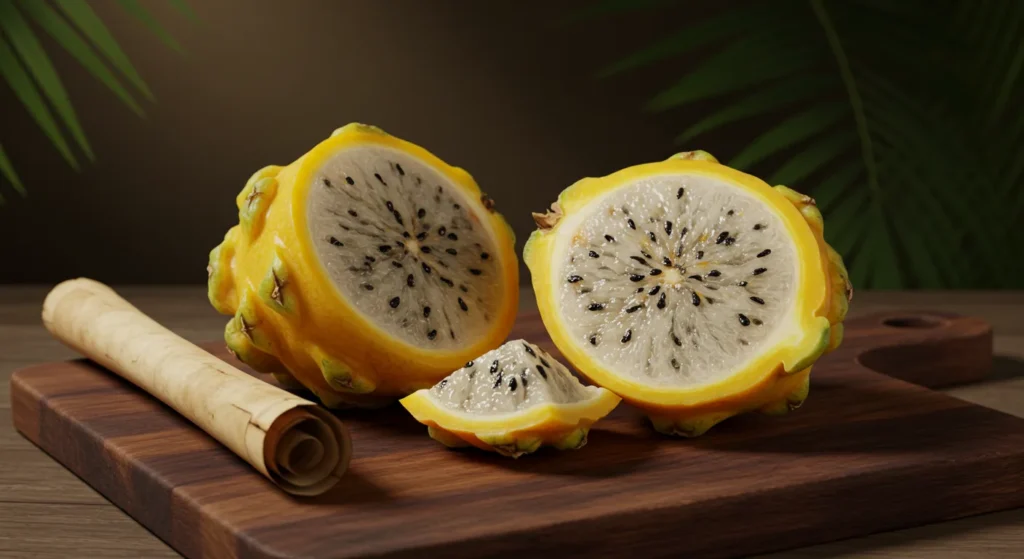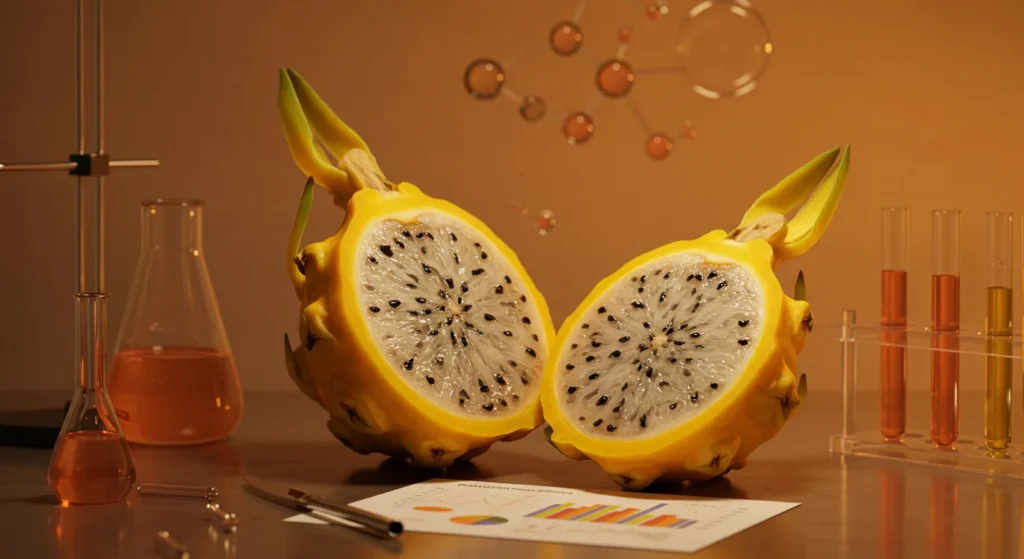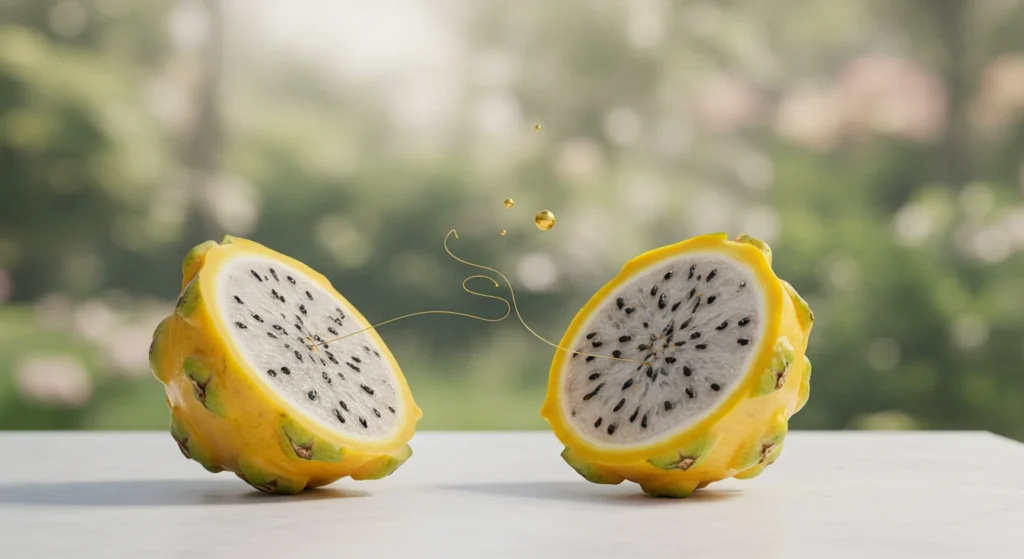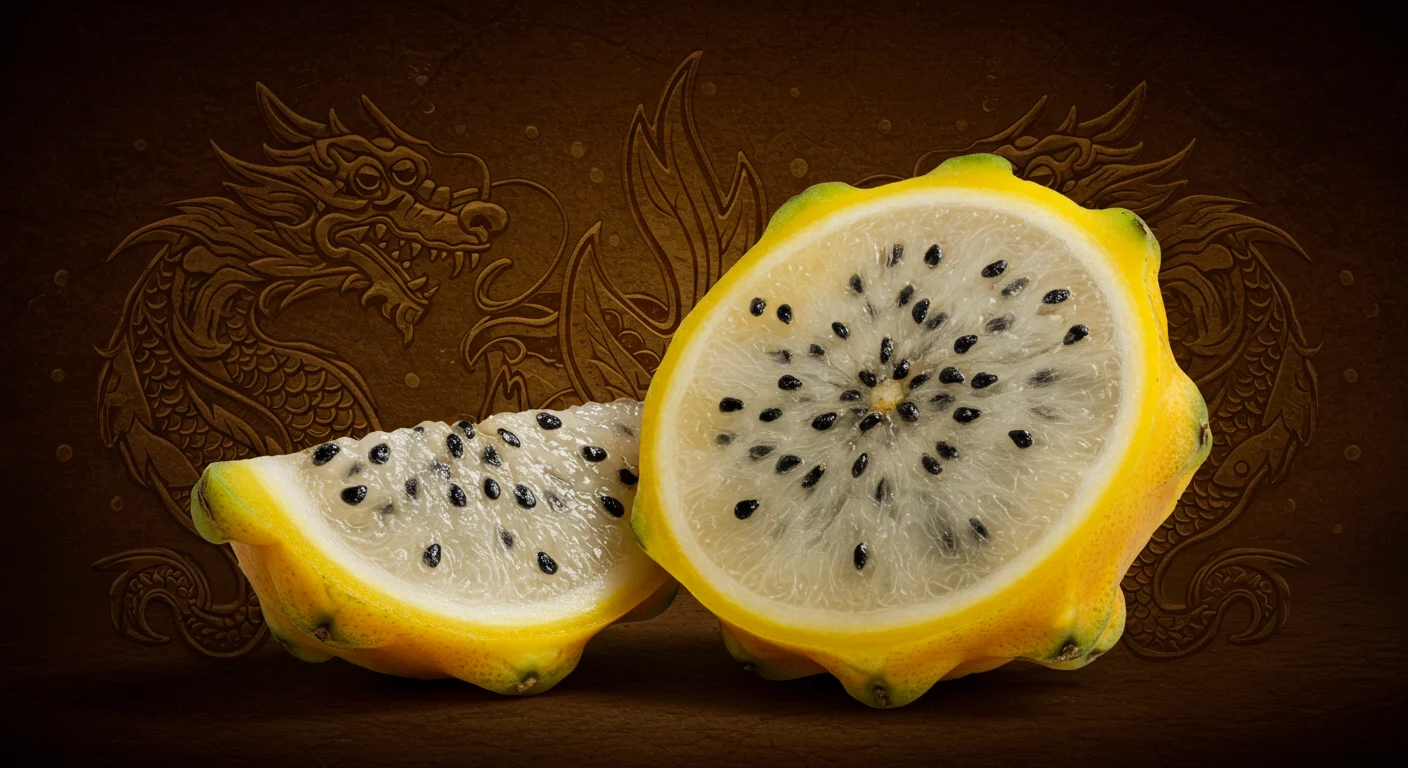The Golden Treasure often referred to as a tropical jewel, is not just a feast for the eyes but also a treasure trove of nutrients and health benefits. In this article, we will delve deep into its origins, unique characteristics, nutritional value, culinary uses, and economic impact. Join us on a journey to discover this golden delight that is capturing hearts and taste buds across the globe.
Introduction to Yellow Dragon Fruit
The world of exotic fruits is vast and diverse, yet few can captivate enthusiasts quite like the Yellow Dragon Fruit. Known scientifically as Hylocereus megalanthus, this succulent fruit hails from the cactus family and boasts an array of unique features that set it apart from other varieties of dragon fruit. Its striking yellow skin and sweet, creamy flesh make it a favorite among fruit aficionados, but its story goes much deeper than mere aesthetics.
What is Yellow Dragon Fruit?
At first glance, Yellow Dragon Fruit is a visual masterpiece; its vibrant yellow exterior is adorned with green-tipped scales that give it a mythical appearance, hence its name. While it shares the label “dragon fruit” with other varieties—such as the pink-skinned dragon fruit or pitaya—it is distinct in flavor and texture.
Apart from its scientific name, Hylocereus megalanthus, it is commonly known by various names based on regional preferences, including yellow pitaya and gold dragon fruit.
The flesh of Yellow Dragon Fruit is typically white or creamy with tiny black seeds, offering a delightful crunch when consumed. Unlike its red-fleshed counterparts, which may have a more pronounced sweetness, Yellow Dragon Fruit tends to deliver a subtle, honey-like sweetness that makes it incredibly versatile in culinary applications.
Origin and Distribution: Tracing its Roots
To truly appreciate Yellow Dragon Fruit, one must understand its origins and distribution. Native to Central America, particularly countries like Mexico, this fruit has traveled across borders and oceans over the centuries, finding its way into the hearts and homes of many around the world.
Interestingly, the cultivation of Yellow Dragon Fruit has expanded significantly, especially in Southeast Asia. Countries such as Vietnam, Thailand, and the Philippines have embraced this exotic fruit, both for local consumption and export. The adaptability of the Yellow Dragon Fruit plant to different climates has facilitated its spread, making it a beloved choice in many tropical and subtropical regions.

Unique Characteristics: What Sets it Apart from Other Dragon Fruit Varieties
One of the standout features of Yellow Dragon Fruit is its color. The bright yellow skin, complemented by the contrast of the green scales, immediately draws attention. But beyond its visual appeal, Yellow Dragon Fruit possesses a creamier texture compared to other varieties, which can sometimes be gritty.
In terms of flavor, many describe Yellow Dragon Fruit as having notes of kiwi or pear, adding to its charm in the culinary world. Furthermore, it is worth noting that this variety is less acidic than some red-fleshed dragon fruits, making it a gentler option for those with sensitive stomachs.
Growing Regions: Where is it Commercially Grown?
As mentioned earlier, Yellow Dragon Fruit thrives in warm climates, making it a common sight in several regions globally. The primary growing areas include parts of South America, where it originated, and Asia, particularly Vietnam and Thailand, which have developed extensive plantations dedicated to this exotic fruit.
Sustainable farming practices are increasingly being employed in these regions, emphasizing organic cultivation methods that resonate with health-conscious consumers. This focus on sustainable agriculture not only helps meet the rising global demand but also ensures that the land remains fertile and fruitful for generations to come.
Popularity and Demand: Why is it Gaining Traction Globally?
The increasing popularity of Yellow Dragon Fruit can be attributed to several factors. First and foremost, social media has played a significant role in showcasing the beauty and versatility of this fruit. As influencers and food bloggers share vibrant images of their colorful dishes featuring Yellow Dragon Fruit, interest has surged.
Moreover, consumers are becoming more health-conscious and are seeking out nutrient-rich foods. The myriad of health benefits associated with Yellow Dragon Fruit, combined with its unique flavor profile, has captivated the attention of food enthusiasts worldwide.
Additionally, the growing trend towards plant-based diets has further fueled the demand for exotic fruits, as individuals seek out new ingredients to incorporate into their meals. All these factors combined make Yellow Dragon Fruit a sought-after item in markets and online retailers alike.

Nutritional Profile and Health Benefits
When it comes to nutrition, Yellow Dragon Fruit doesn’t disappoint. Packed with essential vitamins, minerals, and antioxidants, it has earned its place as a superfood in health circles.
Key Nutrients: Vitamins, Minerals, and Antioxidants
Yellow Dragon Fruit is a powerhouse of nutrients. It is rich in vitamin C, which supports immune function and skin health, while its high fiber content promotes digestive health. Additionally, this fruit contains important minerals like calcium, iron, and magnesium, contributing to overall well-being.
Antioxidants found in Yellow Dragon Fruit, such as betalains and flavonoids, play a critical role in combating oxidative stress, making it a valuable addition to a balanced diet. By consuming this fruit regularly, individuals can nourish their bodies while enjoying its delightful taste.
Health Benefits: Supporting Claims with Scientific Evidence
Numerous studies have highlighted the potential health benefits of Yellow Dragon Fruit, paving the way for its recognition in the health community. Research indicates that regular consumption of this fruit may help lower cholesterol levels, improve heart health, and reduce the risk of chronic diseases.
Furthermore, due to its antioxidant properties, Yellow Dragon Fruit may assist in reducing inflammation throughout the body, potentially alleviating symptoms related to conditions such as arthritis. Though more research is needed to fully substantiate these claims, early findings suggest that incorporating Yellow Dragon Fruit into one’s diet can be beneficial for overall health.
Digestive Health: The Role of Fiber
One of the standout features of Yellow Dragon Fruit is its impressive fiber content. Dietary fiber is crucial for maintaining a healthy digestive system, supporting regular bowel movements, and preventing constipation.
The presence of prebiotic fibers in Yellow Dragon Fruit may also foster the growth of beneficial gut bacteria, promoting a balanced microbiome. A healthy gut can lead to improved digestion, better nutrient absorption, and enhanced immune function. By incorporating Yellow Dragon Fruit into meals, individuals can take proactive steps toward supporting their digestive health.
Antioxidant Power: Combating Free Radicals
Free radicals are unstable molecules that can cause damage to cells and contribute to aging and disease progression. Fortunately, Yellow Dragon Fruit is brimming with antioxidants that help neutralize these harmful agents.
The antioxidants present in Yellow Dragon Fruit work synergistically to protect the body from oxidative stress, providing a defense mechanism against cellular damage. This protective effect is particularly vital for maintaining overall health and longevity, making Yellow Dragon Fruit a smart dietary choice.
Potential Benefits for Blood Sugar Control: Research Overview
Emerging research suggests that Yellow Dragon Fruit may positively influence blood sugar levels. Some studies indicate that the fiber and antioxidant content of this fruit could help regulate glucose metabolism, making it a suitable option for individuals managing diabetes.
While the evidence is still in its infancy, incorporating Yellow Dragon Fruit into a balanced diet alongside traditional diabetes management strategies may provide additional support for controlling blood sugar levels.
Varieties and Cultivation
Diving deeper into the fascinating world of Yellow Dragon Fruit reveals a range of varieties and cultivation techniques that contribute to its widespread popularity.
Different Varieties of Yellow Dragon Fruit
Although Hylocereus megalanthus is the primary species associated with Yellow Dragon Fruit, there are several cultivars within this category that offer varying flavors and textures. Each cultivar exhibits its own attributes, allowing farmers to select the type that best suits their growing conditions and market demands.
These varieties may differ in size, sweetness, and even skin texture. Experimenting with different cultivars can offer exciting opportunities for consumers and chefs looking to elevate their culinary creations.
Optimal Growing Conditions: Climate, Soil, and Sunlight
Creating an environment conducive to growing Yellow Dragon Fruit involves understanding its optimal growing conditions. This cactus species flourishes in warm, tropical climates, requiring plenty of sunlight and well-draining soil.
Ideal temperatures for growth typically range between 65°F and 95°F, and adequate rainfall or irrigation is essential. Growers should ensure that the soil pH remains slightly acidic to neutral for optimal nutrient uptake. By adhering to these guidelines, farmers can maximize yields while minimizing issues related to pests and diseases.
Planting and Propagation Techniques
Propagation of Yellow Dragon Fruit can occur through seed planting or cuttings, with the latter being the most common method for commercial growers. Cuttings taken from healthy, mature plants can be placed directly into the soil to encourage root development.
Once planted, it’s vital to monitor the plants closely, ensuring proper watering and sunlight exposure. As they grow, providing support structures like trellises can enhance growth and facilitate harvesting, ultimately leading to a successful crop.
Common Pests and Diseases: Identification and Management
Like any other fruit-bearing plant, Yellow Dragon Fruit is susceptible to various pests and diseases. Common threats include aphids, mealybugs, and fungal infections, which can hinder growth and affect fruit quality.
Regular monitoring and timely intervention are crucial for managing pest populations. Organic pest control methods, such as introducing beneficial insects or using neem oil sprays, can effectively combat infestations while minimizing harm to the environment.
Harvesting and Post-Harvest Handling: Ensuring Quality
Harvesting Yellow Dragon Fruit requires skill and care to ensure that the fruits are picked at the right time for maximum flavor and texture. Typically, fruits should be harvested when the skin has turned a vibrant yellow and the scales have started to soften slightly.
After harvesting, proper handling is essential to maintain freshness and prevent spoilage. Keeping the fruits cool and storing them in perforated containers allows for adequate airflow, extending their shelf life and ensuring that consumers receive the highest quality product.

Culinary Uses and Recipes
Beyond its nutritional profile, Yellow Dragon Fruit is an exciting ingredient that invites creativity in the kitchen. From refreshing smoothies to elegant salads, its versatile nature lends itself to a broad spectrum of culinary applications.
Flavor Profile: A Descriptive Tasting Experience
The moment you slice open a Yellow Dragon Fruit, the allure of its creamy flesh beckons. Its mild sweetness, akin to a blend of kiwi and pear, tantalizes the palate without overwhelming the senses. The small black seeds add a delightful crunch, making each bite an adventure.
This flavor profile allows Yellow Dragon Fruit to shine in both sweet and savory dishes. Whether enjoyed on its own or as part of a complex recipe, the natural sweetness pairs beautifully with other ingredients, enhancing the overall dining experience.
Culinary Applications: From Desserts to Savory Dishes
Yellow Dragon Fruit’s adaptability in the kitchen opens up endless possibilities for culinary experimentation.
In desserts, it can be blended into smoothies, freeze into popsicles, or used as a stunning topping for pavlovas and tarts. Its vibrant color elevates any dish, making it visually appealing while adding a refreshing burst of flavor.
For savory applications, consider incorporating Yellow Dragon Fruit into salads, salsas, or even grilled dishes. Its mild taste complements a variety of ingredients, including avocado, seafood, and citrus, allowing creative cooks to push the boundaries of flavor combinations.
Classic Yellow Dragon Fruit Recipes: Smoothies, Salads, and More
To showcase the culinary versatility of Yellow Dragon Fruit, here are a few classic recipes that highlight its unique qualities:
- Yellow Dragon Fruit Smoothie: Blend together ripe Yellow Dragon Fruit, banana, coconut milk, and a splash of lime juice for a refreshing morning boost. Garnish with mint leaves for an extra touch of flavor.
- Tropical Salad: Combine diced Yellow Dragon Fruit with mango, cucumber, and fresh herbs like cilantro or mint. Drizzle with lime vinaigrette for a zesty salad that excites the palate.
- Dragon Fruit Salsa: Mix chopped Yellow Dragon Fruit with tomatoes, red onion, jalapeño, and lime juice for a vibrant salsa that pairs perfectly with grilled fish or chicken.
Each of these recipes showcases the unique flavor and texture of Yellow Dragon Fruit while inviting culinary creativity.
Creative Uses: Exploring Unconventional Culinary Applications
While traditional recipes showcase the beauty of Yellow Dragon Fruit, consider exploring unconventional culinary uses that push the boundaries of flavor.
For instance, think about incorporating Yellow Dragon Fruit into sauces, marinades, or even cocktails. Its natural sweetness can balance out tangy flavors, creating a harmonious blend that surprises and delights guests.
Another creative idea is to use Yellow Dragon Fruit as a base for sorbets or ice creams. Its flavorful essence provides a refreshing treat ideal for warm weather or special occasions.
Tips for Selecting and Storing Yellow Dragon Fruit
Choosing the perfect Yellow Dragon Fruit is key to experiencing its delightful flavor.First, look for fruits with vibrant yellow skin and minimal blemishes or soft spots. A firm exterior typically indicates ripeness.
Once selected, store Yellow Dragon Fruit in a cool, dry place or refrigerate it to prolong freshness. Whole fruits can last up to a week in the fridge, while cut fruit should be stored in an airtight container to maintain its quality.
Economic Impact and Market Trends
As the demand for Yellow Dragon Fruit continues to rise, so too does its significance in the global market. Farmers are discovering the economic benefits of cultivating this exotic fruit, leading to a burgeoning industry that holds promise for sustainable growth.
Global Market Overview: Current Trends and Future Projections
The global market for Yellow Dragon Fruit is witnessing exponential growth, driven by increased consumer awareness of its health benefits and culinary versatility. With more people focused on plant-based diets and nutritious foods, Yellow Dragon Fruit has established itself as a desirable ingredient across various cuisines.
Market projections indicate continued expansion, as producers work to meet the demand both domestically and internationally. Initiatives aimed at promoting Yellow Dragon Fruit in restaurants and grocery stores further cement its position as a popular choice among consumers.
Export and Import Dynamics: Major Players in the Market
Countries like Vietnam and Thailand have emerged as major exporters of Yellow Dragon Fruit, capitalizing on the growing international appetite for this unique fruit. The logistics surrounding the export of Yellow Dragon Fruit require careful planning to ensure the product maintains its quality during transit.
Conversely, importing countries are discovering the value of incorporating Yellow Dragon Fruit into their offerings. Markets in North America and Europe are becoming increasingly receptive to exotic fruits, presenting opportunities for producers to expand their reach and establish new trade routes.
Economic Benefits for Farmers: Sustainable Income Opportunities
For farmers, cultivating Yellow Dragon Fruit can lead to sustainable income opportunities. The relatively low maintenance requirements and ability to thrive in various climatic conditions make it an attractive crop choice.
Rising demand means higher prices for Yellow Dragon Fruit, enabling farmers to secure better financial returns on their investments. Additionally, the fruit’s reputation as a superfood aligns with consumer trends toward health-conscious purchasing, ensuring a steady customer base.
Challenges and Opportunities in the Yellow Dragon Fruit Industry
Despite the promising outlook for the Yellow Dragon Fruit industry, challenges remain. Producers must navigate fluctuating market prices and competition from alternative fruits.
However, these challenges also present opportunities for innovation and growth. Emphasizing sustainable farming practices can differentiate growers and attract environmentally conscious consumers. Additionally, investment in marketing and education around Yellow Dragon Fruit can amplify public interest and drive sales.
Sustainability Considerations: Eco-friendly Farming Practices
Sustainability is increasingly becoming a priority in agriculture, and the Yellow Dragon Fruit industry is no exception. Many growers are adopting eco-friendly practices to minimize their environmental impact, including organic farming methods and responsible water usage.
By prioritizing sustainability, farmers can create a positive feedback loop that enhances the health of their crops and contributes to the well-being of their communities. Consumers are drawn to products that align with their values, making sustainability a key driver in the future success of Yellow Dragon Fruit.
Conclusion
In conclusion, the Yellow Dragon Fruit is more than just a beautiful fruit; it is a multifaceted gem that offers a wealth of nutritional benefits, culinary possibilities, and economic opportunities. Its journey from its origins in Central America to its establishment in global markets highlights its adaptability and appeal across cultures.
As consumers continue to seek out healthy, flavorful options, Yellow Dragon Fruit stands poised to capture their interest and imagination. Whether enjoyed in a smoothie, salad, or as a stand-alone snack, the fruit world promises to leave a lasting impression on all who indulge.
Ultimately, embracing Yellow Dragon Fruit means celebrating not only its delicious taste but also the rich tapestry of history, health, and sustainability that accompanies it. Here’s to the future of Yellow Dragon Fruit—may it continue to flourish and delight palates around the world!
For more recipes please click on below links:
Dive into Branzino Meat: Explore its Flavor and Culinary Versatility
Easy Eggless Sausage Hashbrown Breakfast Casserole Recipe – Make Mornings Delicious and Hassle-Free

